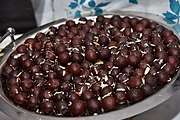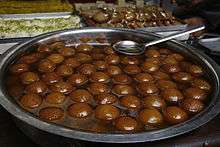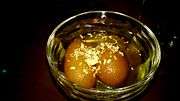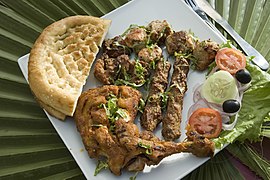Gulab jamun
Gulab jamun (also spelled gulaab jamun) is a milk-solid-based sweet from the Indian subcontinent, and a type of mithai, popular in India, Nepal, Pakistan (where it is known as gulab jamun), the Maldives (where it is known as gulaabujaanu), and Bangladesh (where it is known as gulab jam), as well as Myanmar. It is also common in Mauritius, Fiji, the Malay Peninsula, South Africa, and the Caribbean countries of Trinidad and Tobago, (where it is called rasgulla), Guyana, and Suriname. It is made mainly from milk solids, traditionally from khoya, which is milk reduced to the consistency of a soft dough. Modern recipes call for dried or powdered milk instead of khoya. It is often garnished with dried nuts such as almonds and cashews to enhance flavour.
_bright.jpg) Gulab jamun topped with almond slivers | |
| Alternative names | Gulab jaman (Northern India/Pakistan), lal mohan (North India/Nepal), gulabjam (Eastern India/Bangladesh), gulaabujaanu in Maldives |
|---|---|
| Course | Dessert |
| Place of origin | Indian subcontinent |
| Region or state | Indian subcontinent, Mauritius, Fiji, southern and eastern Africa, the Caribbean, the Malay Peninsula |
| Serving temperature | Hot, cold, or room temperature |
| Main ingredients | Khoa, saffron |
| Variations | Pantua, kalo jam |
Preparation
In the Indian subcontinent, milk and cheese solids are prepared by heating milk over a low flame for a long time until the water content has evaporated and only the milk solids remain. These milk solids, known as khoya, are kneaded into a dough, with a small amount of flour (maida), and then shaped into small balls and deep-fried in oil or ghee (clarified butter) at a low temperature of about 148 °C[1] until they get their familiar golden brown color. If the balls are cooked quickly, they will be raw on the inside. The fried balls are then soaked in a light sugar syrup flavored with green cardamom and rose water, kewra or saffron.[2]
Origins
The origin of the dish is debatable.
A sweet very similar to the modern Gulab Jamun, Pantua and Ledikeni, but made of rice flour, is mentioned in the 12th century Indian, Sanskrit-language text Manasollasa.[3]
According to one theory, Gulab jamun was first prepared in medieval India and may have been derived from a fritter that Central Asian Turkic invaders brought to India.[4] Other theory claims that it was accidentally prepared by the Mughal emperor Shah Jahan's personal chef.[5]
The word "Gulab" is derived from the Persian words gol (flower) and āb (water), referring to the rose water-scented syrup. "Jamun" or "jaman" is the Hindi word for Syzygium jambolanum, an Indian fruit with a similar size and shape, commonly known as black plum.[6] Jamun is also defined as a fried delicacy in sugar syrup.[7] The Arab dessert luqmat al-qadi is similar to gulab jamun, although it uses a different batter. According to the culinary historian Michael Krondl, both luqmat al-qadi and gulab jamun may have derived from a Persian dish, with rose water syrup being a common connection between the two.[8]
Consumption customs
Gulab jamun is a dessert often eaten at festivals, birthdays or major celebrations such as marriages, the Muslim celebrations of Eid ul-Fitr and Eid al-Adha, and the Hindu festival of Diwali (the Indian festival of light). There are various types of gulab jamun and every variety has a distinct taste and appearance.
 Gulab jamun in a glass
Gulab jamun in a glass Gulab jamun with almond pieces
Gulab jamun with almond pieces Gulab jamun often comes with chashni syrup
Gulab jamun often comes with chashni syrup- Served with saffron
- With vark
 Two pieces of Gulab jamun
Two pieces of Gulab jamun
Variants
India
Gulab jamun gets its brownish red colour because of the sugar content in the milk powder (khoya). In other types of gulab jamun, sugar is added in the batter, and after frying, the sugar caramelization gives it its dark, almost black colour, which is then called kala jam or "black jam". The sugar syrup may be replaced with (slightly) diluted maple syrup for a gulab jamun.
Homemade gulab jamun is usually made up of powdered milk, a pinch of all-purpose flour (optional), baking powder and clarified butter (ghee); kneaded to form a dough, moulded into balls, deep fried and dropped into simmering sugar syrup.
Pantua is similar to gulab jamun, and could be called a Bengali variant of that dish.[5] Ledikeni, a variation of Pantua, is another variant of gulab jamun.[9] It is said to have been invented by Bhim Chandra Nag on the occasion of a visit by Lady Canning, the wife of Charles Canning, the Governor-General of India during 1856-62.
Katangi, a town near Jabalpur is famous for "Jhurre Ka Rasgulla", which has been made there for the past 100 years.[10][11] It is several times the size of normal gulab jamuns and is prepared in local desi ghee.[12]
In Rajasthan, instead of soaking gulab jamun balls in sugar syrup, they are cooked in gravy made from nuts and tomato to make popular Gulab Jamun ki Sabzi.
Bangladesh
In Bangladesh, Pantua is available almost everywhere throughout the country, which can be referred to a Bengali variation of Gulab jamun. Also there are two kinds of jamuns that are famous. They are Golap Jam (গোলাপ জাম) and Kalo Jam (কালো জাম).
See also
- Rasgulla
- Bamiyeh
- Chè xôi nước
- Leche frita
- Doughnut holes
- List of desserts
- Loukoumades
- Lyangcha
- Tangyuan
- Puff-puff
References
- Marty Snortum, Lachu Moorjani (2005). Ajanta: regional feasts of India. Gibbs Smith. p. 17. ISBN 1-58685-777-0.
- shraddha.bht. "Gulab Jamoon". Konkani Recipes. Retrieved 25 May 2010.
- Michael Krondl (2011). Sweet Invention: A History of Dessert. Chicago Review Press. pp. 41–42. ISBN 978-1-55652-954-2.
- Michael Krondl (1 June 2014). The Donut: History, Recipes, and Lore from Boston to Berlin. Chicago Review Press. p. 7. ISBN 978-1-61374-673-8.
- Charmaine O'Brien (2003). Flavours Of Delhi: A Food Lover's Guide. Penguin Books Limited. p. 145. ISBN 978-93-5118-237-5.
- [Banerjee, A; Dasgupta, N; De, B (2005). "In vitro study of antioxidant activity of Syzygium cumini fruit". Food Chemistry. 90 (4): 727. doi:10.1016/j.foodchem.2004.04.033]
- Achaya K. T. "Indian Food Tradition A Historical Companion". Retrieved 29 January 2019.
- Michael Krondl (2011). Sweet Invention: A History of Dessert. Chicago Review Press. p. 38. ISBN 978-1-55652-954-2.
- Richardson, Tim H. (2002). Sweets: A History of Candy. Bloomsbury USA. p. 334. ISBN 1-58234-229-6.
- "यहां के रसगुल्लों के लिए थम जाते हैं वाहनों के पहिए". www.patrika.com. Retrieved 24 September 2019.
- उसमें प्राण जगाओ साथी- 3, मायाराम सुरजन, Deshbandhu, 2009-11-12, जबलपुर-दमोह के बीच कटंगी के रसगुल्ले, 1959
- "Folk music. Katangi ke rasgulla. AKASH sahu". Retrieved 24 September 2019 – via www.youtube.com.
External links
| Wikimedia Commons has media related to Gulab jamun. |



